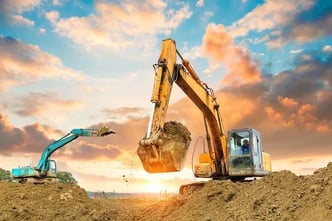Hydraulic hose failure is a common occurrence, particularly when not shielded by sleeves, wraps or other hose protection products. Most failures of pressurized hydraulic hose are caused by repeated abrasion, extreme temperatures, excessive UV exposure, improper routing, kinked hoses, tube erosion, fluid incompatibility or inadequate fitting installation and improper hose assembly. Hose failures are often very serious and can cause system failure or personal injury.

Hose Burst
System failure results in equipment shutdown which leads to costly downtime and expensive repairs. In addition, under high pressures there is the potential of serious physical injury from hydraulic injection caused by hoses bursting or pinhole leaks.
ISO 3457 sets forth requirements regarding "line-of-sight sleeving" to play a critical role in protecting equipment and workers against hose failure. It maintains that hydraulic hoses shall be guarded when containing fluid at pressures which exceed 725 psi and/or temperature over 140°F (60°C) and are located within 3' 3" (0.99 meters) of an operator. The ISO specification continues to state that hose guards and flexible hose coverings must be strong and sturdy for stopping, dispersing, or diverting a fluid stream in the case of hose failure to prevent direct contact with and operator or maintenance personnel.

To protect against these failures, there are hose sleeves rated for burst pressure of up to 20,000 psi, can protect against a 1mm pin hole leak of up to 4,000 psi and carry a melting point rating of 480°F (248°C).
Abrasion
Hydraulic hoses are usually in frequent or constant motion on heavy equipment, or machinery in a manufacturing plant. They will also stretch or constrict as system pressure changes. Hoses often rub against each other (or metal edges) because of this condition, usually resulting in abrasion. Abrasion is a very common cause of hydraulic hose failure as the outer cover wears away. This can expose the reinforcing steel wires to wear and corrosion, allowing pressure from the core to eventually leak fluid. Hose failure due to abrasion is very common, unless it's protected by an outer sleeve.
system pressure changes. Hoses often rub against each other (or metal edges) because of this condition, usually resulting in abrasion. Abrasion is a very common cause of hydraulic hose failure as the outer cover wears away. This can expose the reinforcing steel wires to wear and corrosion, allowing pressure from the core to eventually leak fluid. Hose failure due to abrasion is very common, unless it's protected by an outer sleeve.
ISO 6945 is the International Standard, which specifies how to determine the abrasion resistance of the outer cover of hydraulic hoses that include wire or textile reinforcement. Because of varying material types, wall thickness and other factors, the standard does not specify the number of cycles required during testing. 6945 does not predict product service life from abrasion, instead it is used to compare quality levels. However, the specific manufacturer product specification should indicate the cycles the product can withstand under extreme conditions.
Again, this is why utilizing hose sleeves is the safest method for protecting against abrasion. Using the 6945 standard to test hose sleeves, indicating a capability of withstanding at least 250,000 abrasion cycles demonstrates that certain sleeves are the best method for shielding hydraulic hose from abrasion to increase equipment service life and protect workers.
Some products incorporate plasticizers in the material of the hose cover to reduce abrasion. In specific problem areas, with higher-than-usual pressure fluctuations, high frequency hose movement or metal surfaces scraping, a nylon sleeve or plastic guard can be used to add extra protection to the hose.
Conclusion
Hose failure can reduce equipment service life, cause expensive system shutdown or even endanger your employees. High quality and durable hose sleeves provide extra protection from what can be catastrophic hydraulic hose failure. The fact that hydraulic hose is exposed to extreme conditions more often than not, it's practical to use hose sleeves during installation or servicing.
Protective hose sleeves should be able to withstand burst pressures at or above that of the hose rating and able to hold back high-pressure pin hole leaks. They should also have a denier level of at least 1300 to ensure the material is durable, sturdy and thick enough under extreme conditions. Denier is the unit of measurement which states the thickness of textile braid fibers used in some hose products.
The toughest hose protection sleeves also provide:
- Excellent resistance to UV light and other atmospheric agents
- Long service life
- Very good chemical compatibility
- Zero toxicity
- Less bulk than alternatives
Whether you're specifying, installing or maintaining hydraulic hose, always consider the benefits of high-quality hose sleeves to ensure worker safety and a long service life for your equipment.
To learn more about another essential component of hydraulic systems, check out our free BluPrint discussing hydraulic manifolds:

